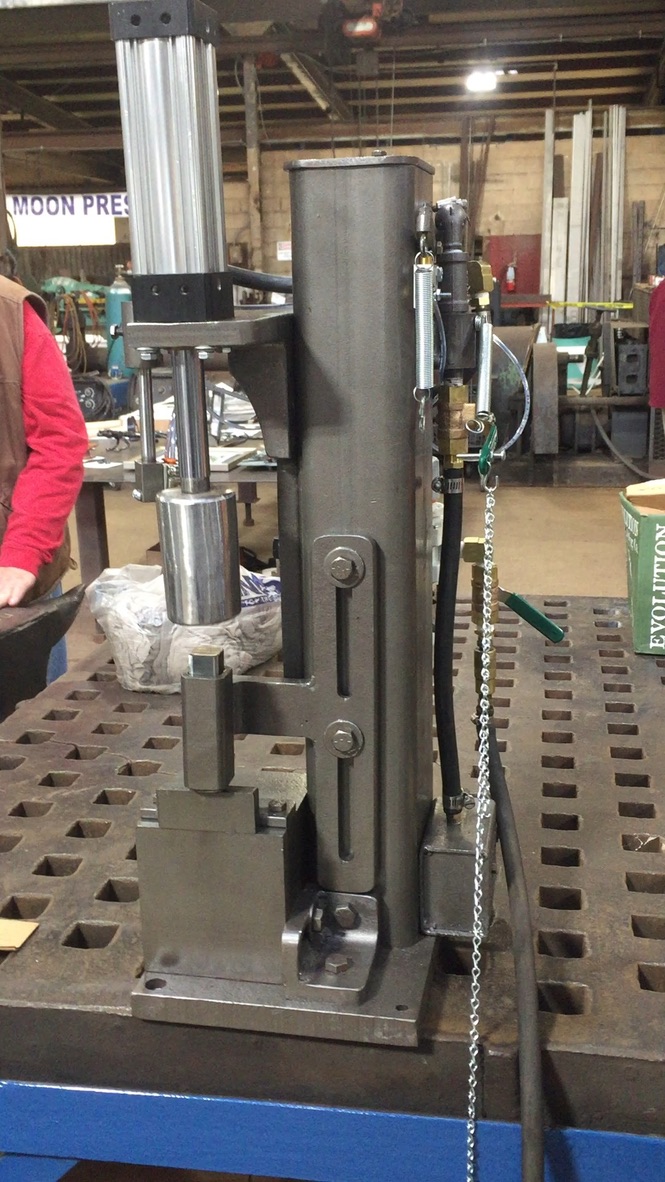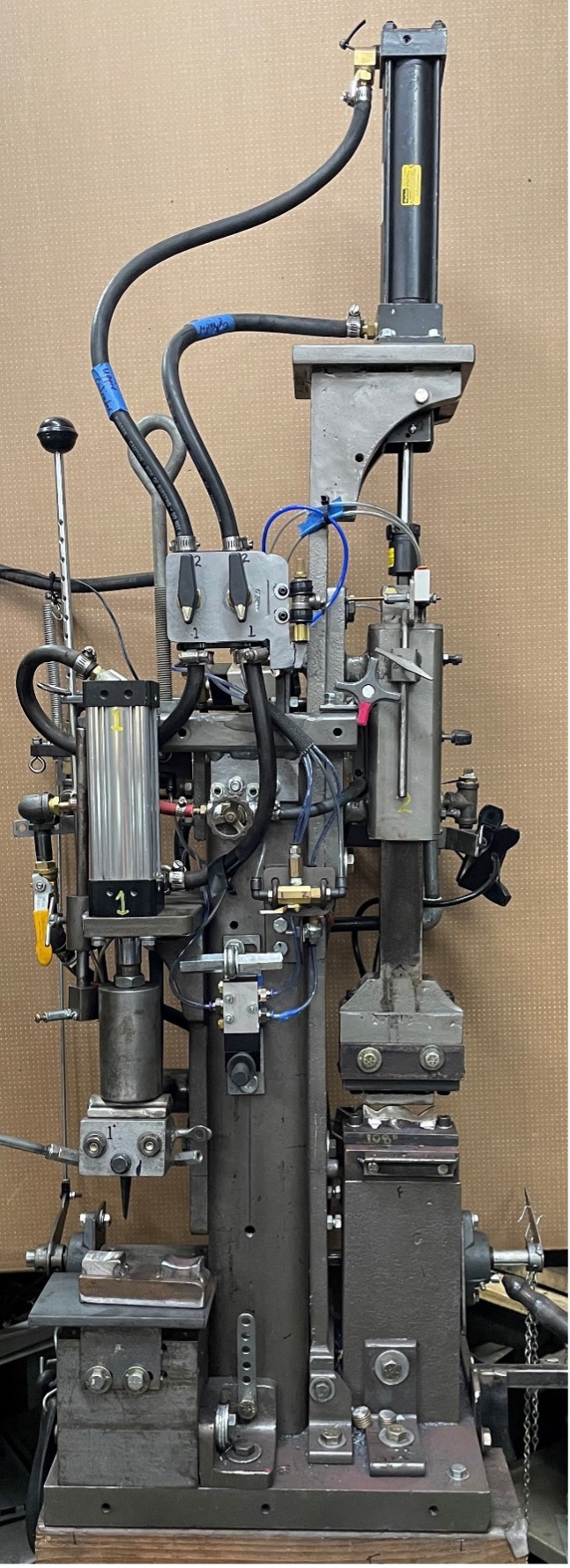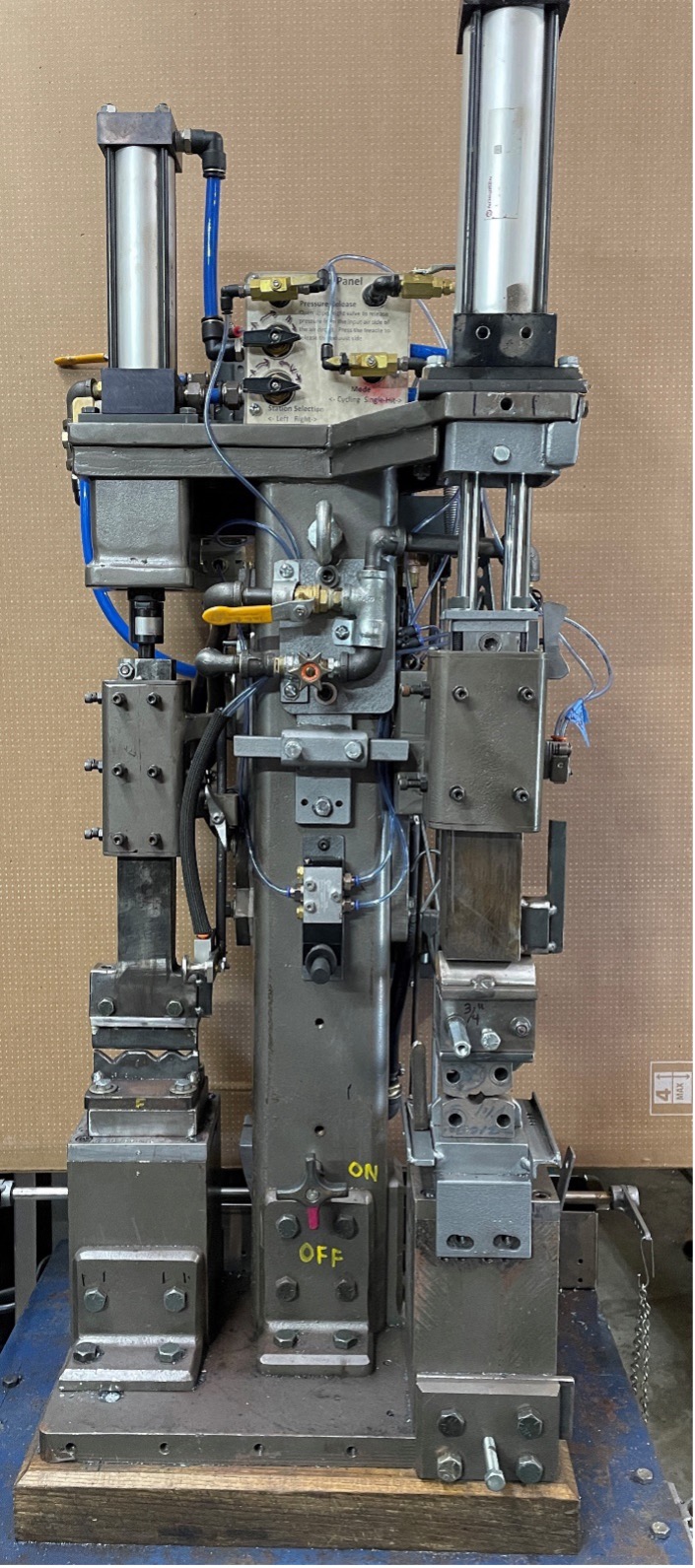Descriptions of the specialty hammers used by Bruce Jarrell.
As told by Dave Hammer
The First Speciality Hammer. In January of 2020 (at the MASA Gichner's Memorial Conference), I brought Bruce a hammer with an unguided ram that struck tooling that was held in a stationary arm. The cylinder bracket and arm could be repositioned vertically to accomodate different tooling and forged objects. The anvil could also be moved forward and back to allow positioning of various lower dies.

The Original Hammer.
I knew this would not be the final configuration of this hammer, but it was a start to be able to move work to a power hammer he could not do with his larger hammers. I merely replaced a tool I saw him using in his shop (on an anvil) when he was working on leaves and fullering other objects.
Bruce took the hammer home with a huge smile on his face. Over the next few months (yes, during the early days of covid), we modified the original configuration (changed the stationary arm into a swinging arm) and added a second forging station on the right side. Bruce would advise me what he would like to do with the hammer.... and we would make a plan. We spent many Sundays working in my shop, planning and upgrading to add capabilities.
Over the next three years, we built two more dual-station hammers, adding features to support his wish lists (we collaborated on function). The second hammer is more powerful than the first. The third hammer is slightly smaller (easier to move) and was built to be the hammer that would be used for demonstrations.
After some use, Bruce re-positioned controls (moved valves) so he could more easily do operational procedures while he was sitting. He set up foot pedals (rather than using treadles) because they are more friendly while sitting on a stool while forging.
The hammers are called Explorers, with a descriptive addition assigned for each model. As of this time, Bruce has the only Explorers in existence. The original Explorer is the “Explorer Model A”, the second, the “Explorer Model B” and the third is referred to as the “Explorer Model A Traveler”, made especially for traveling and demonstrations.
Two forging stations (the traditional ram and swinging arm under a ram) are built on a single frame. This requires fewer air circuit components, results in less overall cost, provides a smaller footprint, and features shared foot pedals when compared to two single-station hammers. Having two stations is very convenient. It eliminates the need for the operator to get up and move to another hammer.
Either side can be operated in a usual cycling mode, or a true single-strike mode (at a set impact force). Single strikes can also be obtained in cycling mode by quickly tapping the foot pedal.
Some of the upper modules of the forging stations are vertically movable to accommodate radically different forging heights if needed. The Traveler has fixed upper modules to reduce weight and is less adjustable.
Cycling speed is controlled over a wide range using foot pedals. Pressing down a little produces slow-speed cycles; cycling speed increases as the foot pedal is further pressed down. Pressing all the way down will result in maximum cycling speed (restricted to speed set by a governor).
All these features combined provide significant control of cycling speed, stroke position and impact force.
Common capabilities:
* Two forging stations: a ram-based system and a (ram struck) swinging arm system,
* An air valve system that allows rapid switching from one forging station to the other. Three valves are used to switch between stations. An additional valve is used to switch between cycling and single-strike modes.
* A ram weight in the 10–20-pound range,
* Rapid change die systems on the ram and anvil that are highly versatile in accommodating different types of dies and tooling,
* Precise ram control by foot pedal, allowing strikes to be hard or soft, rapid or slow, using cycling or single strike modes,
* A pneumatic governor system that allows the smith to adjust and maintain the ram rhythm and force of the strike.
* A pneumatic control toggle switch that allows precise positioning of the ram. The ram can be raised or lowered to any position before starting to forge or change tooling.
* A slow-rise valve to modify the behavior of the stroke cycle. It allows a normal hard strike downward, but a slow rise before the next hard strike.
* Free-standing arm rests on each side of the hammer for comfort and ease while holding materials in position while forging, and
* Modular in design so that the hammer can be stripped down and transported.
The die mounting systems used on the rams vary from hammer to hammer because of our evolution in design and use. However, the basic design is the same even though the details vary.
Bruce designs and fabricates all the dies he uses.
Control panel positions vary between hammers.

Explorer Model A
The First Hammer, Final Configuration... A dual-station hammer with a shared air circuit.

Explorer Model B
Second Hammer.... Bruce was craving more power. This is the largest hammer with the heaviest rams.

Explorer Model A Traveler.
This is the third hammer. It has a 10-pound ram with a radiused-Vee die setup on the left and 15-pound ram on the right for the swinging arm.

Closeup of the swinging arm. For some operations, a bungee cord holds the arm up slightly during forging. Down pressure is necessary on other operations.

Front view of the swinging arm side.
This right-sided swinging arm arrangement is most convenient for a right-handed smith. Obviously, it could be built on the left if that would be better for the smith.

The control system for the Explorer Traveler.
The valves for switching sides and a single strike mode are mounted on the top of the hammer. The pneumatic governor system is mounted on the central column below the switching valves.

The toggle valve allows precise positioning of the ram on either side and is mounted at the middle of the central column.
Return to Tube Forging Page